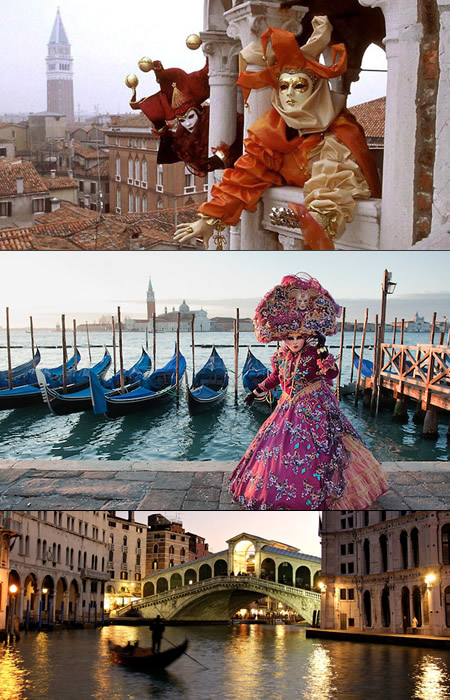 |
 |
|
The word carnival is thought to derive from the Latin carne vale, which translates as "goodbye to meat" and referred to the preparation for the forty day fast that Christians would undertake in Lent. The Carnevale di Venetia is believed to have originated in 1192 as a celebration of the victory over Ulrich II von Treven, who was attempting to bring Venice under German rule. The Doge of Venice, Vitale II Michiel, defeated and captured Ulrich and only allowed his release on payment of an annual tribute of a bull, 12 pigs and 300 loaves of bread. In celebration of this deed, every year a bull and a dozen pigs were sacrificed in the Piazza San Marco on or around Martedi Grasso (Shrove Tuesday) and thus was the Carnevale born. The first reference to the wearing of masks comes in the 13th century, where legislation passed by the Council of Venice in 1268 forbids the practice of masked men throwing scented eggs at ladies. Over the centuries various accepted styles of carnival dress developed. The bauta consisted of a white face-shaped mask, a black cape and a tricorne hat; the moretta was a black velvet oval mask and the medico della peste (plague doctor) was a long-snouted mask based on that used by doctors where the nose contained fragrant herbs that would supposedly offset infection. Many masks were based on those of stock characters from the commedia dell'arte which flourished during the Renaissance. The ability to conceal one's identity was useful for the Venetian gentlemen (and ladies) who frequented the gambling houses which flourished in the city. The carnevale also became a symbolic focus for the feuding between the two gangs of Venice: the Castellani - made up of sailors - and the Nicolotti - the fishermen. The regular fist-fights between the factions had been outlawed in 1505, but their rivalry continued at the carnevale, where they challenged each other to games and feats such as building rival human pyramids. The carnevale fell out of favour when Venice succumbed to the Austria yoke in 1798 and it was later banned completely by Mussolini. It was not until 1979 that the festivities were officially encouraged again and began to regain some of their former glory. The highlight of today's carnevale is a sumptuous masked ball - Il Gran Ballo della Cavalchina which takes place at the Teatro la Feniche. |
|